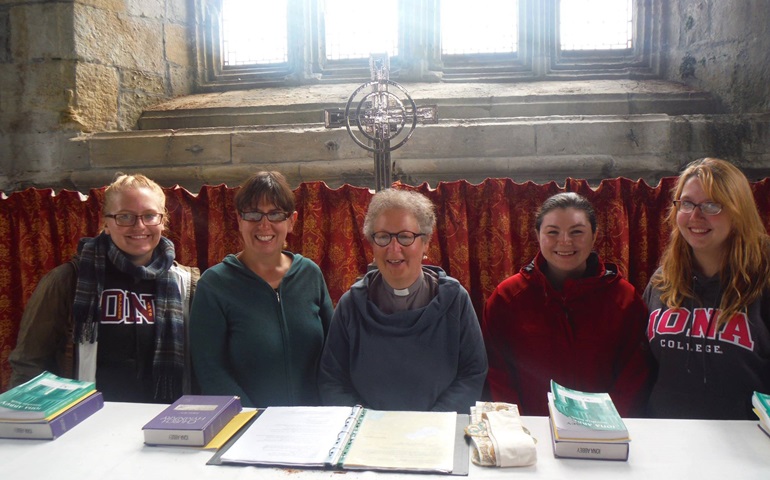
Michelle Muzzio loves the winged creatures of earth. So her trek last summer to the Isle of Iona off Scotland’s southwestern shores soared with feathered synchronicity. It was the perfect place to be.
The word “Iona” means “dove,” and Muzzio, who has had pet cockatiels since she was seven, found herself each day serenaded by the cooing of the island’s namesakes. On the isle as part of an Iona College (New Rochelle, N.Y.) interdisciplinary class in Celtic spirituality, the junior English and chemistry major recalls her delight in spotting them gathered in stone arches around the Iona monastery.
“The sight caught us off guard because the doves were just as peaceful as the rest of the Isle,” she told NCR in an email. “It was a peace that could never be captured anywhere else. Iona has been called the closest place between heaven and earth and this encompasses perfectly what the island felt like.”
Iona served as the location where St. Columba founded his first abbey in western Scotland, and became the jumping-off point for his evangelization of Britain beginning in 563.
This year marks the 1,450th anniversary of Columba’s arrival from Ireland with 12 of his fellow monks. Some historians speculate that he came to Iona after being kicked out for illegally copying a set of the Christian scriptures. Another story has him leaving voluntarily, full of remorse and sadness because he had taken his family’s side in a tribal feud. The fight turned into a full-scale battle resulting in 3,000 casualties.
Columba’s name is another synchronicity for Muzzio. Both the Gaelic -- Colum Cille -- and the Latin translate as “church dove.”
The course on Celtic spirituality, taught by Christina Carlson, an associate English professor at Iona, brought Muzzio and two classmates to the tiny isle for an experiential walk in the saint’s footsteps.
Celtic spirituality was what Columba and his monks were all about, reflecting their ancient Irish heritage, Carlson told NCR.
“Celtic spirituality doesn’t create a dichotomy between the physical and spiritual worlds. It doesn’t separate them out, as some Christian traditions ask us to do,” she said. “We can pray atop a mountain as easily as we can in a church.”
Columba was known for his outdoor communing with the Divine. According to writer John Philip Newell, Columba liked to pray on a large fairy hill known as Sithean Mor every day “as the great fire of the sun dipped into the Atlantic.” As Newall tells the story, the hill became known as the Hill of the Angels after a young monk once followed the abbot to observe his evening prayer practice and reported he saw angels “descending and ascending” on Columba as he prayed.
Carlson notes that nature and the cosmos permeate many of the prayers attributed to Columba. In one, he asks God to “be a bright flame before me, a guiding star above me.” In another Columba reverences the “Iona of my heart, Iona of my love, instead of monks’ voices shall be the lowing of cows. But ere the world shall come to an end, Iona shall be as it was.”
Columba’s cosmology sees animals as our friends because they are part of creation, Carlson said.
During their trip, the Iona students became heavily immersed in the saint’s energy. They explored the beach, collecting dozens of the small stones known as Columba’s tears -- a result of the monk’s homesick weeping on the beach for his beloved Ireland. The story goes his copious tears fell to the ground and crystallized into healing stones.
The students also climbed the hills and walked grounds of Iona Abbey. Their days enlivened thanks to the present-day descendants of the doves, puffins, cormorants, dolphins, seals and sheep that were so much a part of these ancient monks’ everyday lives. The wildflowers and the dragonflies dazzled their eyes and souls.
One morning, just past 5 a.m., they felt the discomfort of going out into the cold rain and fog to climb Dun’l, the highest point on the isle. The fog “would not lift, but it still was one of the beautiful sights to behold,” said Muzzio. “We realized how Columba saw this Island. It only required us seeing it as he did for us to really understand it.”
Kaylynn Murchison, a junior English major, echoed her classmate, describing in an email how deeply affected she was by the island’s mystical, spiritual milieu: “One can only really understand that after being there.”
The American group resided at Iona Abbey, now run by an ecumenical Christian group called the Iona Community. The site is actually a refurbished 13th-century Benedictine monastery that fell victim to the English Reformation. Upon its founding in 1938, the Iona Community began breathing new life into the old buildings.
Most of the buildings of Columba’s day were destroyed in 802 during a Viking raid. A small stone beehive-shaped building at the top of a hill is believed to be one the original structures -- a place people could go for solitude, Carlson speculated.
Her students spent part of each day creating illuminated manuscripts in one of the monastery’s workrooms. Carlson had her students take a special class on manuscript writing before their trip to Iona, arriving, she said, with “beautiful blank journals to fill with their art.”
“Illuminated manuscripts were so important in Columba’s day,” she told NCR. “The Roman Empire had fallen and the culture had disintegrated. Monks were the only literate people who were left.”
Copying books and preserving texts became an additional job to the monks’ workload of farm work, prayer, and caring for their sheep. Some copied the Scriptures, poetry, saints’ lives and even travel chronicles, while others would carry the completed works into the countryside to preach the Gospel to indigenous Scottish tribes. The Book of Kells, a collection of the four Gospels created on Iona, now resides at Trinity College in Dublin.
Outside the abbey, Iona’s ecological seamlessness and welcoming attitude extends to other parts of the island, home to 120 permanent residents. The local golf course, for instance, is not a sacrosanct space limited to players only, but rather common space for all who visit -- tourists, hikers, dog walkers, and even sheep and cows.
“Can you imagine such a thing happening here in the U.S.?” Carlson asked.




